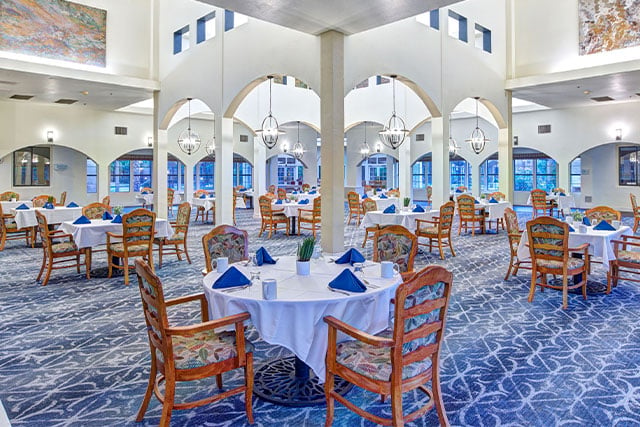
“Imagine eating at the same restaurant every day for 10 months!” Fighting food boredom is an underlying theme of Justin W.’s role as dining services director at Ridges at Peoria Senior Living in Peoria, AZ. He believes that food and the dining experience remain the cornerstone in everyone’s life, regardless of age. No wonder, then, that when prospective residents tour, food quality and the dining experience is a make-or-break part of the experience. If the meals in his communities are lackluster, then every department is.
Instead, “a smile, a menu full of choices and making minor adjustments to meet individual preferences go a long way,” he says. “With the right culture and love, a complaint turns into a suggestion and “sorry we can’t accommodate” turns into a wonderful experience.”
How do communities managed by The Goodman Group ensure each resident’s food journey is a tasty, healthy, wonderful experience? We asked Justin to tell us more.
Feeding the Whole Body
The dining experience can enhance this chapter in a resident’s life. Food not only provides senior nutrition and calories, but it also offers fellowship and helps relieve depression and sickness. Justin has seen new residents go from driving their scooters everywhere to walking in a few months. Health services and culinary team members communicate about dietary needs and concerns and make a plan through the dining experience to better each resident’s life.
With the right menu items, residents can retain healthier numbers with a full stomach in a bright, welcoming culture.
Care Level Differences
At Ridges at Peoria Senior Living, the dining experience takes place simultaneously in three locations, with minor differences depending on several variables.
- In memory care, the key considerations are the presentation of food and timing. The presentation goes a long way when someone has dementia. Making entrees “pop” helps the food to catch their eyes and makes it hard for the stomach to ignore. This promotes better eating, nutrition and hydration, which are all top priorities. Offering a variety of choices ensures meals hit all resident preferences.
A consistent schedule is also essential. “They can’t wait too long,” Justin says, “and we can’t be too quick in a memory care dining room.”
- For assisted living, key considerations are choice and variety. To avoid overly repeating entrees, periodic “culinary corner” meetings bring residents together with the chef, front-of-house supervisor and Justin. Residents deliver praise, express concerns and opinions on specific menu items, and suggest specials. Then Justin and his team plan, order and implement right away.
- Independent living residents have their own kitchenette or a full kitchen in their apartment homes, but Justin frequently hears comments such as “I haven’t used my oven since I moved in” and “I’m glad I don’t have to cook!”
.His goal is to get at least 90% of residents into the dining room for two or three meals a day, and obviously, residents are eager to comply. This makes the dining room a place where residents can make friends and make plans to sit together at certain tables. “It seems they would miss anything in the world to be there,” Justin observes.
Healthy Choices Meet Personal Preferences: We Provide, They Choose
Striving to make each choice and meal better than the last is what keeps Justin and his team happily busy. It’s a balancing act between delivering healthy choices and meeting personal preferences.
Justin’s philosophy is “the more feedback the better, good or bad.” He visits with residents as they are dining, at events, in the hallways and their individual rooms, and he meets with the resident council to hear any concerns. Residents know his team lead and other culinary team members are also great resources.
“The conversation always starts with what we do great and what we could do better,” he says. The concerns he hears most are about minor issues not directly related to the menu. Very rarely are they about a certain entrée or item because his team tries to make the dining experience better from the start.
Minor adjustments are a must, as long as they can be made timely and safely. That might be cutting up food or serving smaller portions. Or it might be about food prep. Some residents like their broccoli with a snap when they bite into it, some would rather have it fall apart. The dining team caters to these preferences, anticipating and executing as much and in as much detail as possible.
Many seniors also have chronic health conditions that dictate what they should eat. Preparing food with low-sodium, herb-based ingredients and recipes keep salt in check without diminishing the flavor. Residents can meet weekly with Justin, his assistant or the chef to discuss menu items and portioning.
For instance, if Mary is diabetic but dearly wants some carrot cake, team members may recommend she eat half now and take the other half home to eat later, or choose the carrot cake now and forgo dessert at dinner. Or Mary could choose a more appropriate dessert such as sugar-free ice cream, pie or jello.
Highly Rated but Always Improving
Justin believes Ridges at Peoria Senior Living residents would rate their food and choices overall an 8 out of 10. Not every entrée is for a particular person, but the variety always keeps the tables full and the kitchens busy.


